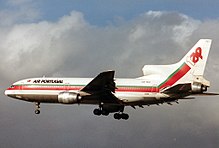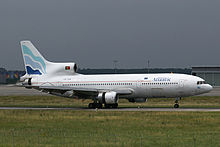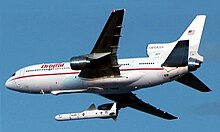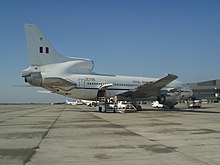Lockheed L-1011 TriStar
| Lockheed L-1011 TriStar | |
|---|---|
 An All Nippon Airways L1011-1 TriStar in October 1991 |
|
| Type: | Wide-body aircraft |
| Design country: | |
| Manufacturer: | |
| First flight: |
November 16, 1970 |
| Commissioning: |
April 26, 1972 |
| Production time: |
1970-1984 |
| Number of pieces: |
250 |
The Lockheed L-1011 TriStar, also known as L-ten-eleven (English pronunciation) or as TriStar (the name was given by Lockheed itself), is a three - engine wide - body aircraft made by the US manufacturer Lockheed , which is also the last civil aircraft from this manufacturer. It is designed in various versions for 250 to 400 passengers, originally for medium- haul routes , later versions also for long-haul routes . Final assembly took place in Palmdale , California; the first flight was carried out on November 16, 1970. From 1970 to 1984 250 L-1011s were delivered, the last machine went to TAP Portugal on March 1, 1984 . The plane was never profitable for Lockheed; As a consequence, the manufacturer withdrew from the civilian market. The Tristar is mostly quite popular with its pilots and is therefore called "Lucky Ten-Eleven".
history

In 1966, American Airlines was looking for a high-capacity, short- and medium-haul aircraft . Douglas was in financial trouble and Boeing was completely busy with the Boeing 747 . Lockheed immediately took the opportunity to find a return to the civil aircraft business after the company had fallen behind due to the failure of the Electra . Initially designed as a twin-engine aircraft, this concept was later discarded in order to switch to a three-engine concept requested by some customers. The new Rolls-Royce RB211 was to be used as the drive , the only three-shaft engine that had the advantage of a very fast thrust change. This remained the only available TriStar engine until the end of production, as no other engines could be installed, which turned out to be a decisive disadvantage. For this reason, many companies preferred to order the DC-10 , among other things in order to be able to choose other engines from General Electric or Pratt & Whitney . In addition, Rolls-Royce was clearly overwhelmed with the development and manufacture of single-crystal turbine blades . The start of production was announced on March 29, 1968. The first flight of the machine took place on November 16, 1970, but economic and technical problems delayed the start of series production until 1972.
At the start of production, Lockheed had a spectacular 144 orders. The first customer was Eastern Air Lines with 25 firm orders. Initially, the L-1011-1 to -200 versions were built as short- and medium-haul aircraft, and from 1975 the -500 version was also a pure long-haul version, which was shortened by 5 m. However, this came too late for the market. Douglas, strengthened by the merger with McDonnell, had a long-haul variant on the market much earlier with the DC-10-30. While the medium-haul versions of the TriStar sold around 200 units compared to the only 140 medium-haul DC-10s, there were hardly any customers for the long-haul version. Just 50 aircraft of this type were sold; of the DC-10 there were over 300. Thus the so-called Trijet Race clearly went to McDonnell-Douglas.
Its main customers were large US airlines such as Eastern Air Lines , TWA , Pan Am and Delta Airlines , outside the USA mainly Air Canada , British Airways and Cathay Pacific . The first European operator was the Court Line . In Germany, the Düsseldorf-based LTU relied exclusively on the TriStar for years.
Manufacturing and logistics
Lockheed built a new factory in Palmdale / California (Plant 10) to manufacture such a large commercial aircraft. This was named The Star Factory in the Desert . A completely new infrastructure had to be created for this in order to be able to guarantee the delivery of parts. Despite many suppliers, Lockheed tried to produce as many parts as possible itself. Only the wings were manufactured as a large component by a supplier. The use of computers in production was set very early on. In 1969 production began in the new factory.
technology
The L-1011 is a conventional wide-body aircraft with three engines. It has a classic three-man cockpit for two pilots and a flight engineer. Nonetheless, Lockheed introduced some technical innovations, especially from military aviation and space travel, with this aircraft. In contrast to Boeing and McDonnell Douglas, for example, there were already so-called “switch lights”, which replaced conventional switches with separate lamps.
hull
The fuselage of the L-1011 is made of aluminum half-shells. For the first time on an aircraft of this size, a metal bonding process was used in part for the paneling. The planking was reinforced with titanium strips that were also glued. This led to a significantly increased service life of the cell. The hull is completely (including the cargo holds) pressurized and heated. The versions -1 to -200 have six large electrically operated passenger doors and two smaller emergency doors in the rear part of the fuselage. In order to be able to carry even more passengers (over 400), there were also normal-sized rear doors with the normal two-lane escape slides, which were used, for example, by the British B-Tours.
It was possible to have the galley installed in a hold; then two elevators were installed that led into the passenger compartment. There were also versions in which the front cargo hold was equipped as a passenger cabin ("Lower Lounge"). A staircase led down from the normal passenger compartment, and a door with a built-in staircase allowed direct entry and exit. Since the “Lower Lounge” had no windows, there was video transmission from the cockpit. These aircraft could be recognized by the reinforced underbody. The cargo holds are accessible through two cargo doors in the lower part of the fuselage and a door from the front electronics compartment under the cockpit. They can accommodate standard containers. In an underfloor kitchen, there was another access to load the kitchen from below.
The third engine is located in the stern in the longitudinal axis of the fuselage. It is supplied with air through an S-shaped tunnel in the fuselage. The auxiliary power unit is installed in front of the engine . Versions -1 to -200 had a retractable tail skid to prevent damage to the rear of the fuselage when it hit the ground. The shortened version -500 no longer had this spur. To this day (2013), the cockpit is considered to be the most spacious of all commercial aircraft.
Wings
The L-1011 has cantilevered wings and is designed as a low-wing aircraft. The wings are designed as all-metal surfaces, have two box spars and a 35 ° sweep. Each wing contains four tanks. A device is attached to the right surface to install a replacement engine for transfer purposes. At the leading edge are the seven-part slats , which are interrupted at the engine mounts. They can be de-iced with the help of hot engine bleed air. Four landing flaps designed as double-slit Fowler flaps are used at the trailing edge , which are interrupted at the level of the engine. This is where the inner aileron is located . The outer ailerons are attached to the outer trailing edge. Six spoilers are attached to the top as spoilers , four of which can be used on the outside to support the ailerons. A direct lift control system is also installed. If the landing flap position (here: the L-1011-500) is more than 30 °, this extends the four inner spoilers to a new neutral position of 9 °. If the aircraft is above its glide path during the landing approach, the DLC system varies the spoilers between 9 and 20 °, below the intended glide path between 9 ° and the retracted position in order to keep the inclination of the aircraft stable on the final approach.
Tail unit
The tail unit is self-supporting and made of metal. When it came to controlling the elevator, Lockheed took an unconventional approach. The horizontal stabilizer consists of a fin and a rudder, but the pilot moves the entire fin (flying stabilizer) and the rudder makes a further mechanical deflection. This system gives the L-1011 excellent control properties. The rudder is conventionally provided with a one-piece rudder. The third engine is installed in the tail cone. Because this, in contrast to the DC-10, lies in the longitudinal axis of the fuselage, the vertical stabilizer is very effective and leads to a very low minimum speed in the event of an engine failure. With the DC-10 this is significantly higher. BWIA used aircraft with an enlarged rudder to achieve even lower approach speeds, which are necessary for some airfields in the Caribbean.
landing gear
The landing gear of the L-1011 consists of a nose landing gear with twin tires and two main landing gear, which are designed as a carriage landing gear with four tires each. The main landing gears are equipped with hydraulically operated disc brakes and an anti-lock braking system.
Flight control
The aircraft is controlled mechanically via control rods and cables, which are converted into movements hydraulically on the control surfaces. The control surfaces are controlled by four independent hydraulic systems. The trimming is done electrically and mechanically, a special feature was the direct, proportional trim wheel in the control horn, which enabled very precise trimming. With its powerful autopilot system, the L-1011 was the first aircraft that had been approved for automatic approaches of category IIIb - i.e. an automatic landing. Two "Autoland" computers with two channels each made excellent automatic landings even in a 30 knot crosswind.
variants
With the L-1011, a distinction has to be made between build versions ex works and subsequent modifications that have also been carried out or authorized by Lockheed. These modifications were also given a version number.
Factory versions
L-1011 -1
Basic version with a take-off weight of 195,045 kg and for max. 400 passengers. Ordered by Eastern Airlines, Trans World Airlines, Delta Air Lines, Air Canada, British Airways, LTU and All Nippon Airways, among others. ( FAA - Type Certificate L-1011-385-1)
L-1011 -100
Further development of the L-1011-1 (FAA type approval L-1011-385-1-15) with reinforcements on the airframe and chassis. They were available with three different take-off weights (including 211,374 or 215,003 kg take-off weight) and a greater range . In addition, the amount of fuel has been increased to 100,000 liters by using the central spar in the fuselage as a fuel tank. Ordered by Cathay Pacific, Gulf Air, Saudia and TWA. 13 copies were built ex works, additional L-1011-100 were upgraded from existing L-1011-1. The -100 version was the last factory-made version of the TriStar with the RB211-22B.
L-1011 -200
Improved version of the L-1011-100 (FAA type certification L-1011-385-1-15) with a new variant of the RB211 engine and an optimized range. An improved flight management system was also installed. Customers included Saudia, British Airways and British Airtours. Numerous older -1 and -100 versions have been converted to the -200 version. 24 copies built ex works.
L-1011-500

Long haul version of the L-1011 (FAA Type Certificate L-1011-385-3). The fuselage was shortened by 4.11 meters, reducing the capacity to 300 passengers. This version only had six large doors on the upper deck and the emergency door at the end of the hull was omitted. The underfloor kitchen was moved upstairs to achieve more cargo capacity. New improved fairing on the tail engine air inlet. The fuselage was extensively reinforced in order to achieve a maximum take-off weight of 231.3 t. The wingspan was increased by 2.74 m. This increased buoyancy was controlled with the so-called Active Control System . This computer-controlled fully automatically moves the outer ailerons synchronously in the same direction in order to counteract the lift and keep the wing loading low. The fuel capacity was increased to 120,000 l by installing three center tanks . In addition, more powerful engines were used. First delivery was in August 1976 to British Airways. It has been used by Pan Am, Air Canada, Air Lanka, Delta Air Lines, TAP Air Portugal, LTU, BWIA International and Royal Jordanian, among others. 50 copies were built.
Modifications
L-1011 -40
Modified L-1011-1 with a take-off weight increased to 199,581 kg.
L-1011 -50
Modified L-1011-1 with a take-off weight increased to 204,117 kg.
L-1011-150
Modified L-1011-1 with a take-off mass of 213,189 or 215,003 kg as well as a higher landing and empty tank weight for an improved range.
L-1011-250
Modified L-1011-1 with extensive structural modifications, a take-off weight increased to 224,982 or 231,332 kg, an increased landing and empty tank weight as well as RB211-524B4 for propulsion and an optionally increased tank capacity.
L-1011 -1F and L-1011 -200F
Freighter modifications of the 'Long Body' variants. In the mid-1980s, an L-1011-1 was converted by Aeronautical Engineers Inc. into the only freighter of the basic version. In the mid-1990s, Marshall Aerospace from Cambridge / GB offered the conversion of all TriStar variants to freighters. The L-1011-200 proved to be the ideal basis, but only ten orders were placed with the US-based freight companies American International Airways, Arrow Air and Millon Air.
L-1011 -K1 and -KC1
TriStar 500, converted by Marshall Aerospace for the British Royal Air Force in the mid-1980s.
Military use and rocket launch aircraft
Some machines were converted for military purposes (transporters, tankers ). Under the name Stargazer , a TriStar serves the private US space company Orbital Sciences as a launch platform for its Pegasus rockets . Since the TriStar construction stop , Lockheed-Martin has dedicated itself exclusively to military aviation and space travel.
After the Falklands War and especially the cumbersome Operation Black Buck , the British Royal Air Force realized that they needed new tanker aircraft for future missions that were also suitable for long-haul routes. It therefore bought six Tristar 500s from British Airways and three from Pan Am . The six British Airways planes were converted to tanker aircraft between 1982 and 1984 to complement the Vickers VC10 . The Pan-Am-Tristars remained largely unchanged and were used to transport soldiers. In total, the Royal Air Force owned four versions of the Tristar 500:
- Two K1 are tanker planes that could transport up to 136 tons of fuel. Alternatively, when used as a transport aircraft, they could carry 187 soldiers and be refueled in the air themselves.
- Four KC1 corresponded to the K1, but had an additional large loading hatch on the left side through which freight pallets could be loaded.
- Two C2 corresponded largely to the civilian machines and could carry 260 soldiers.
- A C2A corresponded to the C2 version , but had additional military communication and command facilities.
All machines were equipped with a Joint Tactical Information Distribution System in 2003/04 . In addition, some of the aircraft were equipped with flares and chaffs for defense against missiles. The Tristars of the Royal Air Force, all of the No. 216 Squadron in RAF Brize Norton , were the second largest tanker aircraft in the world at the time.
On July 20, 2009 the machines were temporarily released from their aerial refueling tasks due to technical problems. The tank tasks were therefore transferred to the VC10 of the 101st Squadron , also stationed in Brize Norton . Due to the age of the machines, it was planned to replace them with the VC10 by 2010 as part of the “ Future Strategic Tanker Aircraft ” program with the Airbus A330-200 MRTT .
However, due to delays in its acquisition, the Tristars remained in use until March 2014. In order to guarantee the supply of spare parts to the fleet by then, the RAF had already taken over the entire spare parts warehouse of Air Transat and the bankrupt ATA Airlines (including two complete machines) and was negotiating the three still available ATA L-1011-500s to take over.
Whereabouts and current operator
EuroAtlantic Airways was the last civil European operator to flee its only L-1011 in spring 2010.
In 2015, the private US security company AGD-Systems operated six L1011-K and L1011-KC tankers. All jets are currently in storage in the Aircraft Graveyard at Bruntingthorpe Airfield , England . Three Barq Aviation L-1011s parked in Ras al Khaimah have been waiting since 2013 to be made airworthy again and then to operate under Peruvian registration. In the meantime, however, the machines are no longer registered in Peru, but have been sold to United Wings Inc. and (officially) exported to Panama. In fact, the machines are still parked in Ras al Khaimah. Of the last-mentioned aircraft, one each was registered with Uganda Air Cargo and TriStar History and Preservation , but was recorded as parked at the end of 2015.
The US company Tempus is now planning to acquire six former Tristar tankers from former RAF stocks.
In 2018, out of 250 L-1011s produced, only one is still registered as active:
-
 United States : Orbital Sciences (1; operated as research vehicle)
United States : Orbital Sciences (1; operated as research vehicle)
Incidents
From the first flight in 1970 to December 2018, there were 10 total losses with the L-1011 Tristar, but three of the losses occurred on parked machines. In 4 of the total losses, 551 people were killed.
- On December 29, 1972, an Eastern Air Lines L-1011-1 crashed while approaching Miami in the Everglades after the crew had been distracted by a defective nose landing gear light. Of the 176 people on board, 103 died, 73 survived the crash (see Eastern Air Lines flight 401 ) .
- On April 19, 1974, an L-1011-1 of the Trans World Airlines burned out in Boston / USA during maintenance work. There were no dead or injured.
- On August 19, 1980, a Saudi Arabian Airlines L-1011-200 burned out after an emergency landing at Riyadh airport . After the aircraft made an emergency landing, all 301 people on board were killed due to incorrect reactions from the crew and ground crews after landing. Among other things, the captain failed to bring the aircraft to a stop in time and to evacuate it (see also Saudi Arabian Airlines flight 163 ) .
- On December 22, 1980, a fatal incident occurred on board an L-1011-200 (HZ-AHJ) over the Gulf of Bahrain . A torn rim caused an explosion during the climb , which tore an approximately 100 × 45 cm hole in the cabin floor. In addition to a few injured on the plane, a 14-year-old girl and a year-and-a-half-year-old boy, whose bodies could not be recovered, were sucked out of the plane through the hole. After the accident, the heavily damaged aircraft was repaired (see also Saudia flight 162 ) .
- On August 2, 1985, a Delta Air Lines L-1011-1 (N726DA) crashed near Dallas / USA while approaching. The machine was caught in extreme wind shear and crashed onto a highway. 134 people were killed and 29 survived the accident (see also Delta Air Lines flight 191 ) .
- On May 3, 1986, an Air Lanka L-1011-100 was destroyed in a bomb explosion during loading in Colombo . 21 people were killed (see also Air-Lanka flight 512 ) .
- On June 28, 1991 an L-1011-1 of the LTU (D-AERI) burned out during maintenance work in Düsseldorf . There were no deaths or injuries, but the machine was completely destroyed.
- On July 30, 1992, a Trans World Airlines L-1011-1 was destroyed in a failed takeoff in New York City / USA. All occupants survived the accident.
- On August 23, 1995, a Delta Air Lines L-1011-1 was severely damaged during cruise due to a sudden loss of pressure. The machine was able to land in Los Angeles / USA, but was written off as a total write-off. There were no victims.
- On July 6, 2001, an Air Transat L-1011-150 was severely damaged by hail after taking off from Lyon / France. The plane landed safely in Lyon, but was written off as a total write-off. There were no victims.
- On August 8, 2002, an L-1011-250 from Hewa Bora Airways returned to Kinshasa / Congo after an engine explosion and landed with a significantly excessive landing weight. The aircraft was badly damaged and had to be written off. There were no victims.
Technical specifications
| Parameter | Data of the L-1011-200 | Data of the L-1011-500 |
|---|---|---|
| crew | 3 cockpit + cabin crew | |
| Passengers | Max. 400 | Max. 315 |
| length | 54.40 m | 50.04 m |
| span | 47.35 m | 50.09 m |
| height | 16.87 m | |
| Hull diameter | 5.97 m | |
| Cabin width | 5.76 m | |
| Max. Takeoff mass | 215,003 kg | 231,332 kg |
| Top speed | 970 km / h | |
| Cruising speed | 880 km / h | 894 km / h |
| Service ceiling | 13,600 m | |
| Range | 7,700 km | 9,900 km |
| Engines | 3 × turbofan engines Rolls-Royce RB211-524 | 3 × turbofan engines Rolls-Royce RB211-524B4 |
| Thrust | 3 × 213.5 kN | 3 × 222 kN |
See also
literature
- Jim Upton: Airliner Tech Series Volume 8, LOCKHEED L-1011 TRISTAR. Specialty Press, North Branch 2001/2002, ISBN 1-58007-037-X .
- Ulrich Kappner: NARA Type Books Volume 8, Lockheed L-1011 TriStar. NARA-Verlag, Allershausen 1993, ISBN 3-925671-12-9 .
- Bill Yenne: Lockheed . Crescent Books, 1987.
- DJ Ingells: L-1011 TriStar and the Lockheed story . TA B-Aero, 1973.
- CD Bright: The jet makers: the aerospace industry from 1945 to 1972 . University Press of Kansas, 1978.
- John Newhouse: The Sporty Game. The High-Risk Competitive Business of Making and Selling Commercial Airliners . Alfred A. Knopf, 1982.
Web links
- German Lockheed TriStar Information Center - Detailed information including résumé and photos of each L-1011 produced
- FliegerWeb.com: Lockheed L-1011 TriStar
- Civil Aviation: Lockheed TriStar
- The Lockheed L-1011 at globalsecurity.org (English)
Individual evidence
- ↑
- ↑ Transaer Rasa - Fleet Planelogger with the Peruvian license plates reserved for Tristar
- ↑ Jordan's Barq Aviation takes redelivery of Tristars , Ch-aviation, December 12, 2015
- ↑ ch-aviation.ch - Aircraft Quick Search (English) accessed on November 29, 2015
- ^ Tempus buys aircraft, will market air-to-air refueling services; Janes, 14 August 2017 ( Memento from 15 August 2017 in the Internet Archive )
- ↑ Lockheed L-1011 TriStar Production list | Airfleets aviation. In: airfleets.net. Retrieved October 11, 2018 .
- ↑ Orbital Sciences N140SC (Lockheed L-1011 TriStar - MSN 1067) (Ex 4R-TNJ C-FTNJ) | Airfleets aviation. Retrieved October 11, 2018 .
- ↑ Lockheed L-1011 TriStar accident statistics , Aviation Safety Network , accessed on January 14, 2019.
- ^ Accident report L-1011 HZ-AHK , Aviation Safety Network (English), accessed on January 3, 2019.
- ^ Accident report L-1011 HZ-AHJ , Aviation Safety Network (English), accessed on January 3, 2019.
- ^ Accident report L-1011 N726DA , Aviation Safety Network (English), accessed on September 6, 2016.
- ^ Accident report L-1011 D-AERI , Aviation Safety Network (English), accessed on December 8, 2017.







